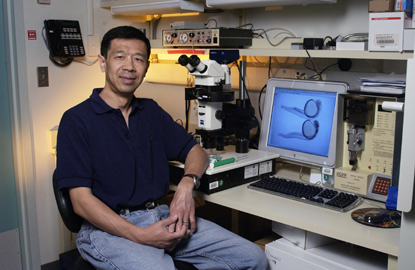Lin Asks Why: An Interview with NHGRI Scientist Paul Liu
Genetic Mechanisms of Hematopoiesis: An Interview with Paul Liu
Five-year-old reporter Lin Wanjek-Yasutake grilled NHGRI researcher Paul Liu, M.D., Ph.D., over lunch last month to learn how chance led him to study leukemia and how, 20 years onward, he is in preclinical experiments. The interview has been lightly edited.

NHGRI scientist Paul Liu.
Lin Wanjek-Yasutake: What are you doing?
Paul Liu: I’m studying the genetic mechanisms of hematopoiesis. One particular research direction is leukemia, specifically, acute myeloid leukemia (AML), which I’ve been working on for about 20 years.
Lin: Why?
Paul: Leukemia is an example of hematopoiesis gone wrong. About 15 to 20 percent of patients with AML have a certain mutation that I found.
Lin: Why?
Paul: That’s the major question. We aren’t sure why the mutation does what it does. But once we learn more, we can better understand other kinds of blood disorders. My lab has many things ongoing. We have animal models. We are doing patient sequencing. And we are developing new treatments for leukemia, which to me is the most exciting part.
Lin: Why?
Paul: It’s coming full circle in my life. We found the initial mutation; studied it; and now hopefully we can target that mutation and help patients. It was by chance that I entered into this research area. Twenty years ago genetic studies were based not on disease but on chromosomes, because it was so hard to study a whole genome. Even a whole chromosome was a big deal. We were concentrating on chromosome 16. We were building YAC [yeast artificial chromosome] libraries, cosmid libraries. All of this research was aided by the Los Alamos National Laboratory in New Mexico, believe it or not.
Lin: Why?
Paul: They have huge facilities with powerful laser sorters. They could separate the chromosomes. If you look at the karyotype, the chromosome map, you will see they are all different sizes. So you can separate chromosomes based on size. That ability was very useful in the early days. You could use that material to build chromosome-specific libraries or chromosome-specific probes and use that for fluorescence in situ hybridization. There was a big push to build a physical map on each chromosome.
Lin: Why?
Paul: So that you could have probes to study disease. I was involved in doing this on chromosome 16. I was working at MD Anderson Cancer Center in Houston. And over lunch, just like this, a hematologist approached me, saying, “Oh, I know you are working on chromosome 16. A major mutation common in leukemia is called chromosome 16 inversion.” It’s literally inverted like this [drawing two genes in switched positions on Lin’s Hello Kitty napkin]. He said, “Would you like to study it and see what’s going on?” And I said, “Sure.”
Lin: Why?
Paul: [laughing] Well, at that time, funding was abundant, and you could do whatever you wanted. Luckily, we found a probe just near the break point. And we found that the inversion generates a fusion gene between the core binding factor beta gene, or CBFB, and MYH11, the gene encoding smooth muscle myosin. So over the years we’ve been trying to understand how this fusion gene contributes to leukemia.
Lin: Why?
Paul: Scientifically, what’s interesting is what this gene does. About 15 to 20 percent of patients with AML have this inversion. And when they have this inversion, they always have a fusion protein, CBFb-SMMHC. The fusion protein blocks normal hematopoiesis. So what we designed a fluorescence in situ hybridization procedure to detect the fusion gene. We have a patent for this diagnostic tool that’s used for all leukemia patients with AML.
Lin: Why?
Paul: Because if they have the fusion gene, it will predict their prognosis. When doctors see it, they will give the patients certain chemotherapy known to help with this kind of leukemia subtype. There are 10,000 to 15,000 cases of AML annually in the United States. Those who have this particular mutation number only about 2,000 to 3,000. So pharmaceutical companies are not interested in developing a targeted treatment. But obviously there is still a sizeable population that could benefit from a targeted treatment.
Lin: Why?
Paul: Good question. I see where you are leading. The interesting thing is that this fusion protein binds to another protein called RUNX1. RUNX1 itself is the target of several chromosome rearrangements seen in leukemia. This finding suggests this whole pathway is important. So now we are studying these proteins together.
Lin: Why?
Paul: Well, I’m not a hematologist. One reason I went into this field was because of my interest in chromosome 16. But since then I’ve seen how this problem provides a fascinating way to understand normal hematopoiesis. It is scientifically and clinically important. In this regard, I’ve benefited from being at the NIH.
Lin: Why?
Paul: We had to create many different mouse models. It’s difficult in the outside world to get funding for such a long-term project. There were many approaches to take and we tried several. We eventually succeeded with a technology called homologous recombination.
Lin: Why?
Paul: This fusion gene is paradoxical. If it’s greatly overexpressed too much, it’s toxic to cells. But with only a subtle change, it can lead to leukemia. It will change the differentiation of blood cells, changes their survival and proliferation. Our mice with the fusion gene will eventually get AML, very similar to human AML. And we were able to show what it does in the pre-leukemia stage.
Lin: Why?
Paul: Because once you get leukemia, you don’t know what went wrong. You need more than one mutated gene to get leukemia. It takes time to develop. If you are unlucky, you get AML earlier. If I can anticipate your next question, the mice don’t have leukemia at birth. We have many ways to demonstrate this finding. You can do random mutagenesis; you can zap them with radiation. The key difference is that if you treat the wild-type mice without the fusion gene with high-dose radiation or a mutagen, they don’t get AML. Maybe they get a thymus tumor. But the mice with the fusion gene will get AML faster than without the mutagen. So we could show how the fusion gene is a contributing factor and a potential drug target.
Lin: Why?
Paul: Well, let me backtrack: We discovered the gene in 1993; we had the mouse model in 1996. Then we were doing basic research studies. But a big breakthrough was the establishment of the NIH Chemical Genomics Center (NCGC), which didn’t come until about five years ago. The NCGC allows you to test many compounds quickly. This wasn’t very feasible before. So now we can use zebrafish to . . .
Lin: Zebra are fish?
Paul: No, no. Zebrafish are small fish with zebra-like stripes. We generated them to contain the fusion gene; they are born with the mutation. If we treat the embryos with various compounds, we can quickly look for the specific defects that we know are induced by the mutation.
Lin: Why?
Paul: The nice thing about zebrafish is that you can easily do high-throughput experiments. You just put a male and female fish together, and they give you hundreds of eggs. And you can make transgenic florescent embryos and label specific cell lineages with bright green or bright red color, so you can score them relatively easily. On 96-well plates, you can put five or six embryos per well so we can test hundreds of compounds quite efficiently. We are collaborating with TRND [Therapeutics for Rare and Neglected Diseases] in NCATS [National Center for Advancing Translational Sciences] to do preclinical studies and hopefully move to clinical trials.

If you have a high-risk, high-reward project to relay, contact us (catalyst@nih.gov) and we’ll send LIN Wanjek-Yasutake (above) to grill you on the details.
Lin: Why?
Paul: This is my first try with preclinical work. I’ve been content with basic research, but I’ve always wanted to do something to improve treatment. The treatments today are usually chemotherapy or bone marrow transplants. Chemo has improved quite a bit. The initial effect is pretty good, but many patients come back. And once they relapse, it’s very hard to treat. A bone marrow transplant isn’t always available. Regardless, many patients still die from leukemia even with the best treatment options. Therefore new and better treatments are clearly needed. A drug might not be optimal, but it can slow the disease. Or it to reduce the dose of chemotherapy. Current chemotherapy is very toxic, especially in elderly patients. Basically, we need many ways—a multiprong attack—to treat AML.
Lin: Oh, okay.
Paul: Nice talking with you.
This page was last updated on Thursday, April 28, 2022
